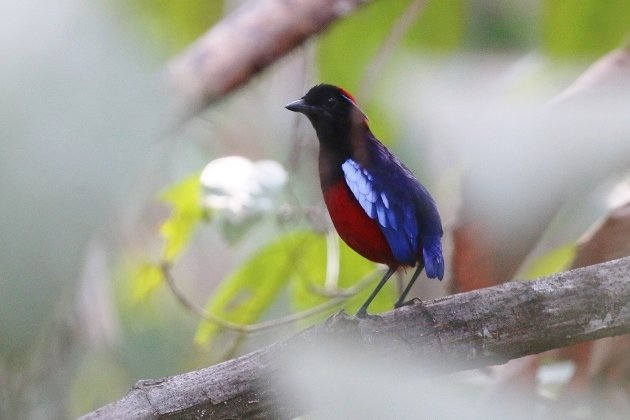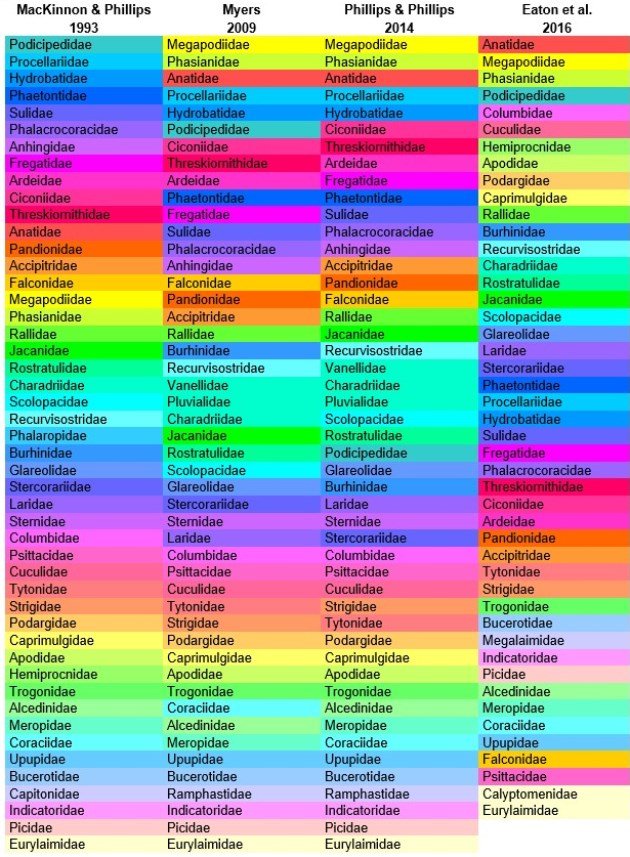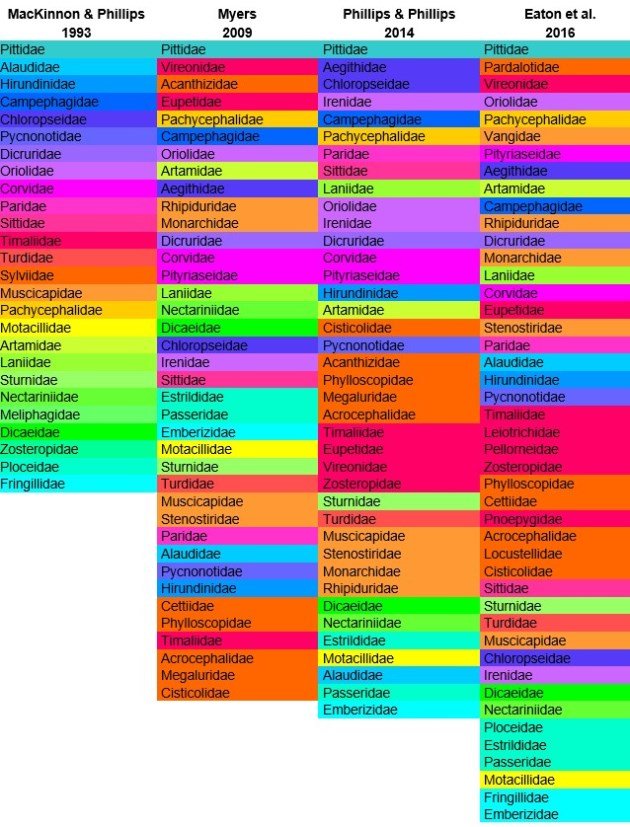
Way back in the days when blog posts still got a lot of comments, I wrote a piece on why field guides that arrange species in a more or less strict taxonomic order regularly frustrate me. I gave a number of reasons in a great number of paragraphs and got an enormous amount of comments, many of which were highly critical of what I had said. The original post is here, and if you have some left-over time, spending it on going through the comments is time well spent. My reasons for not liking a strict taxonomic order were essentially twofold:
- Similar species are not grouped together making identification harder than it should be
- Taxonomy is constantly changing and so does the order of species in field guides
I was recently reminded of how heavy (in my mind and heart) that second reason weighs when I got a copy of “Birds of the Indonesian Archipelago” by J. A. Eaton, B. van Balen, N. W. Brickle & F. E. Rheindt (review here). Since 2012, I was fortunate to spend a considerable amount of time birding through southern Borneo almost each year, and this new book meant that I now have four field guides for Borneo at my service. This is very neat since birders not only don’t wear white, they also use different field guides. Here are the four field guides with a few short comments on their respective order of species:
- MacKinnon J. & K. Phillipps: A field guide to the birds of Borneo, Sumatra, Java and Bali (1993): based on taxonomic order from 1975 with some changes on colour plates for practical reasons
- Myers, S.: Birds of Borneo (2009): based on taxonomic order from 2008, with some changes due to practical reasons, review here. Susan has a brand new edition of her field guide out (she managed to improve her first edition, which is saying something!) where she is also using a different taxonomic oder than in her first edition – see her comment below. However, I am using the different Borneo guides simply as an example of how publication date affects the order of species in field guides in general, and her 2009 field guide gave me a very fitting overall time line.
- Phillipps, Q. & K. Phillipps: Phillipps’ Field Guide to the Birds of Borneo: Sabah, Sarawak, Brunei and Kalimantan, Third Edition (2014): I couldn’t find anything in the introduction, but it appears to be generally a combination of traditional (1993) and newer (2009) taxonomy, review here
- Eaton, J. A., B. van Balen, N. W. Brickle & F. E. Rheindt: Birds of the Indonesian Archipelago (2016): based on current taxonomy (see above)
The new field guide had me going through a few of my mystery photographs and ID challenges again to see if I could find out more than I had been able to squeeze out of the three other books. And of course I did a whole lot of cross-referencing and going back and forth between the different books.
It was a nightmarish thing to do.
The order of species in each field guide was different to such an extend that my thumb started to hurt flipping through the pages. Eventually I gave up and decided that I had to re-visit my old post and publish something on the subject again. Since those comments from my original 2012 post are still ringing in my ear (“you simply should have prepared better”) , I decided to clearly illustrate my point in the following two figures. The figures show the order of bird families in the four field guides mentioned above. For easier reference, I have given the order of families in the oldest field guide (on the left) a spectral colour pattern and used the same colour for the respective families in the other guides. The first figure shows non-songbirds and the second one songbirds. Take your time – text continues below.
Order of bird families, non-songbirds

Order of bird families, songbirds

Do you see a problem? I see a problem. And so do you even if you might not be willing to admit it. Things aren’t too bad for the non-passerines, where a general pattern is still discernible. However, the songbirds are a veritable mess. Take the Alaudidae, the larks, as an example. The larks are represented by only two species taking up less than half a page in each field guide. You won’t find them by just flipping through your different field guides, you’ll have to consult the index. However, even if you have looked up where they are in one book, this is no indication as to where they are in the others. In the book from 1993 they are at the beginning of the songbirds, in 2009 three quarters towards the end, in 2014 almost on the last pages and in the most recent 2016 guide they are right in the middle. You need to refer to the index for all four books.
Crazy!
No amount of getting prepared prior to a trip will make birders know exactly where in their different field guides those species are. You definitely need to make heavy use of the index, and this is not something birders are very keen on doing out in the field while they are trying to sort out the identification of a tricky bird they had just seen. The only thing untouched in the songbird tree is the position of the pittas at the very start of the songbirds. I am quite sure though that this does not reflect taxonomic opinion. The pittas (Garnet Pitta seen above) are just such a sacred group of birds that even taxonomists dare not screw them over.
Look, I am definitely not part of the reason scientists were forced to march the streets recently. I love taxonomic research, speciation in birds was one of my primary subjects during my university days. But this is not about the value and meaning of taxonomy. This is about field identification tools. And I just want my field guide to allow me to identify birds, and do it fast and efficient. Using several field guides is quintessential, but using several books that were published in different years and thus have a vastly different order of species is the very definition of inconvenience and inefficiency. And what, please, do inconvenience and inefficiency have to do in a field guide?
I don’t know – maybe you can tell me?
.













This post is awesome. I love the color-coded infographics that really helped me visualize the difference in the guides.
Also, stop whining. You’ve been to Borneo multiple times.
(Also also, I saw two Yellow-crowned Night-Herons today.)
As always, you bring up thought-provoking insights while reminding us of all the awesome birding you get to do. Well played!
This problem you’ve identified is a big one, considering how fluid our understanding of avian taxonomy seems to be. But how–apart from listing birds in alphabetical or (ugh) color order–could you publish taxonomy-proof field guides?
I’m thinking modular ebooks that reorganize themselves based on list and current structure. Can you put one of those together for us?
Your color-coded visual is great! The changes that cause experienced birders problems have to be a complete nightmare for less experienced birders trying to sort it all out.
I agree with the point about alternative orders! While you complain about annoyances with the changing taxonomic order, you don’t point to any solution. Without taxonomy, every bird guide would still likely use a different order from each other field guide. as the different authors would decide on different ways to group the species.
Taxonomy proof field guides should not be the goal. Recognizing taxonomic order is valuable and helps understand birds better on the whole. However, given the current upheaval the shuffling and guide to guide inconsistency is a bit annoying. However, I judge the books by their accuracy and the quality of the art and the amount of info they can concisely present. And putting swifts and swallows together, or mid-sized black birds together is only useful in beginner’s guides. I really dislike when a taxonomic group is split up among different parts of the guide.
Interesting that the newest field guide for Australia has just been released “The Australian Bird Guide” Peter Menkhorst, Danny Rogers, Rohan Clarke, Jeff Davies, Peter Marsack, Kim Franklin – See more at: http://www.publish.csiro.au/book/6520/#sthash.w75TKwdv.dpuf
It is apparently grouped by habitat……
This post is awesome because you cite my book reviews (and one by Mike). And, the color coding is awesome. And, now you need to go back to the color board, because Susan’s book is out in a second edition! http://www.bloomsbury.com/uk/birds-of-borneo-9781472924445/
I need to do some more thinking about how birds should optimally be organized in a field guide. I think in the future, this won’t be a question because there will be no print books, just digital information that we will retrieve in various ways, including visually. So, you will simply submit your photo and you will receive possible birds. Poof! No need to flip pages!
Hi Susan, I am not on Facebook so I’ll have to respond here in the comments:
My post was not about comparing field guides for Borneo (I might do that in a different post using of course your newest, and very exciting, edition). I was using the different Borneo guides to demonstrate how much the publication date influences the order of species in a field guide. Therefore, I chose your 2009 edition since it offered me a very fitting time line. I will however add to the post that you have a new edition out.
Corey, thanks. But if I stopped whining, what would I drink with my cheese? 😉
Mike: yeah, said the man who had just returned from Panama… Well, if I had the solution to this problem, I’d be rich, rich and famous. But not every restaurant critic has to be a better cook, right? I am thinking that the system in which we arrange species is not so important. What is important is that whatever we use is stable over at least a decade or so. And ebooks? Oh dear… I am not a digital technology buff and absolutely will never give up paper field guides and paper note books. So you’re asking the wrong man.
Jean: thank,s it was fun putting those illustrations together. This is actually a problem that hits beginners and more experienced birders alike since no amount of experience will help you find a hidden one-species family in a new field guide. But true, it must be very confusing for a beginner to even realize why the species are in such a different order in various field guides.
Josh, I agree with you that taxonomy is very helpful even in field identification, and that other systems (like sorting species by habitat, colour, …) are at least equally flawed. Birders are adaptable, and frankly I don’t think the kind of order used is all that important. However, it would be very nice and much, much more user-friendly if whatever system we come up with would remain in place for a certain amount of time so that all field guides published during that period have the same order of species. That oder can be changed every so often, but an overall agreement on which system to use and how often to review it would be ideal.
Jochen I do feel like things are in their state of greatest uoheavel at the moment… I don’t know if it will be five, ten, or twenty years but things should settle out as the phylogeny shakes out with ever more confirmation and less disruption from further genetic studies. I guess in the meanwhile I care most that birds are kept in their taxonomic units. Putting birds in order based upon appearance, size, color, or the like is really defeating in all but the most basic of beginner’s guides.
Steve Howell made an argument about this a while back saying something to the tune of guidebook authors should employ a bit of inertia and aim for a bit more consistency instead of rearranging everything based upon one study, in order to reduce the guide to guide chaos… I agree with this, and I think it is more or less what you are arguing against as well.
Greg, in general I think it is fair to point out a problem without having a solution at hand, even though I understand that this is very easy while getting to a solution is very hard. One solution is that there should be a general agreement on the way species are arranged in field guides. honestly, I think taxonomy is possibly the best since habitat, colour etc. are too variable. My main point is that whatever system gets chosen should remain in place for a long time. Birders will learn and adapt to whatever order they are given, but re-learning and re-adapting every two years is not helping birders excel in what they enjoy the most: looking at birds and knowing what birds they are looking at.
Clare, I am not happy with guides that sort bird species by habitat. This would essentially mean you’d have the species with broad ecologic requirements repeatedly in different chapters. It would be interesting however to see how the Australian guide has managed this. As I have mentioned in previous replies to comments: the system itself is not so much my issue, it is the inconsistency.
Donna, I know, I have Susan’s new edition already and hope to test it in the field later this year. It certainly looks even hotter than her first edition, so you’ll need welding gloves to handle it in the field.
I consciously chose her oldert edition since my main goal was not to compare different field guides to Borneo, it was to compare the order in which field guides present their species for the same region in different years. Susan’s 1st edition was a fitting example of the general taxonomic order in the late 2000’s and fitted in nicely in my “time line” of field guides.
And I strongly reject digital field guides or notebooks etc. in the field. I’ll stick to paper even if it means I one day will have to go birding with a field guide outdated by 30 years. Grrrrr! 😉
Josh, thanks again for your very good comment. One would hope and expect that research on phylogeny will eventually get to a point where the larger groups are sorted and the focus will shift to smaller units, like species and populations. I agree that a taxonomic order is “the lesser of several evils” and have never held a field guide in hand that convinced me with an alternative system, e.g. colour or habitat. In the end, certainly phylogeny will be the most consistent, definite basis for arranging species in field guides.
And that last statement about the argument Steve Howell made is precisely what I’d like to see and what this post is about: a temporary moratorium on taxonomic order in field guides until taxonomic research reaches more quiet waters.
Cheers again for your excellent comments!
buy two copies of each book, cut them all up, put all the pages referring to each bird together in what ever order you like, glue pages together (which is why you need two copies), take to a binder and make your own comprehensive guide. OR to make a lighter version photocopy pages from all your guides, using doublesided printing, make your own index, and bind